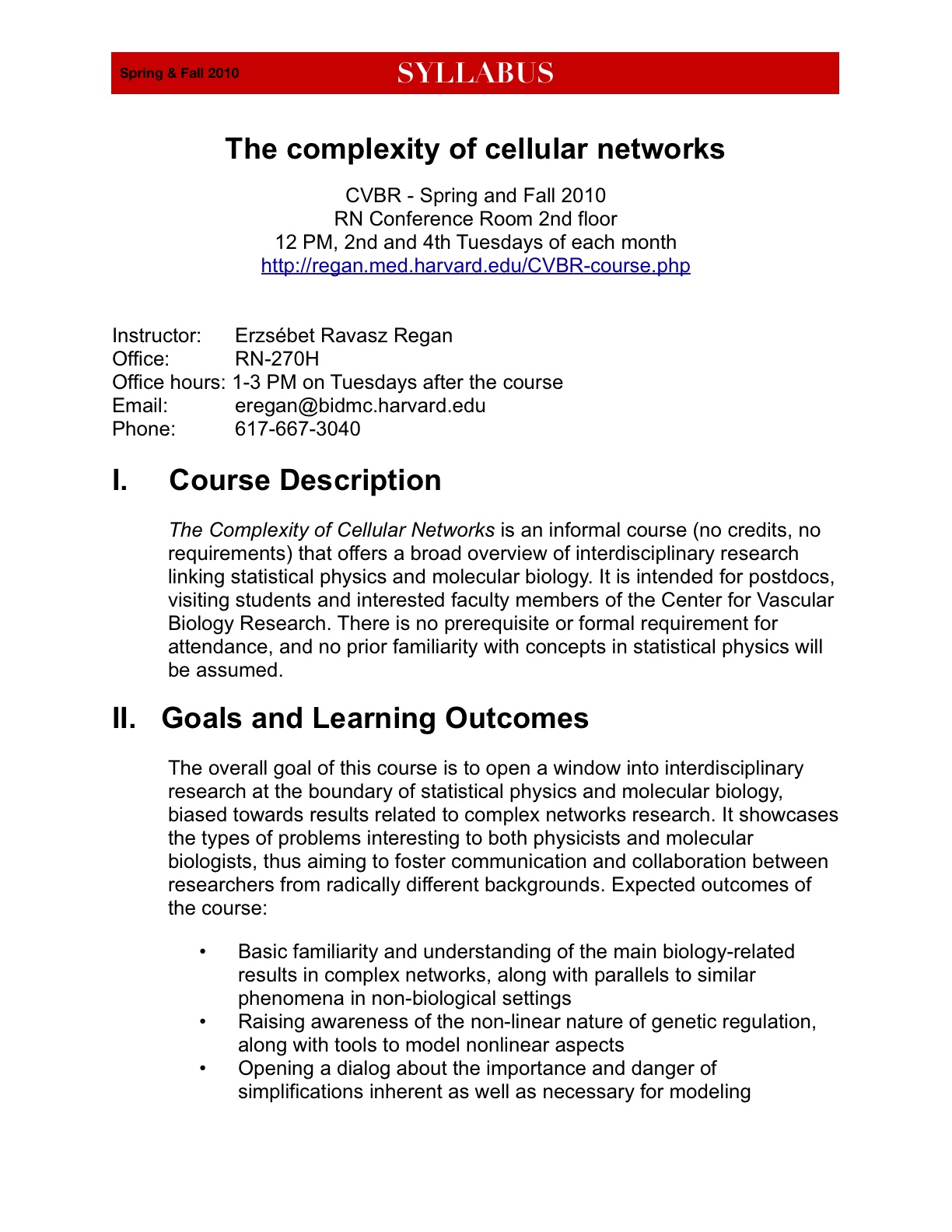|
The complexity of cellular networks
CVBR - Fall
RN Conference Room 2nd floor Time: 12 PM, 2nd and 4th Tuesdays of each month
sample text
Instructor: Erzsébet Ravasz Regan
|
COURSE DESCRIPTION
-
The Complexity of Cellular Networks is an informal course (no credits, no requirements)
that offers a broad overview of interdisciplinary research linking statistical physics
and molecular biology. It is intended for postdocs, visiting students and interested
faculty members of the Center for Vascular Biology Research. There is no prerequisite
or formal requirement for attendance, and no prior familiarity with concepts in statistical physics will be assumed.
GOALS AND LEARNING OUTCOMES
- The overall goal of this course is to open a window into interdisciplinary research at the boundary of statistical physics and molecular biology, biased towards results related to complex networks research. It showcases the types of problems interesting to both physicists and molecular biologists, thus aiming to foster communication and collaboration between researchers from radically different backgrounds. Expected outcomes of the course:
- Basic familiarity and understanding of the main biology-related results in complex networks, along with parallels to similar phenomena in non-biological settings
- Raising awareness of the non-linear nature of genetic regulation, along with tools to model nonlinear aspects
- Opening a dialog about the importance and danger of simplifications inherent as well as necessary for modeling
- Awareness on the part of attending wet-bench biologists of the types of problems that would interest a fellow physicist
OVERALL STRUCTURE
- The course is designed to provide an overview of selected research topics. The typical class session will consist of:
- A 40 minute presentation of the research topic, accompanied by handouts of the presentation citing all relevant reference material, also made available on-line
- The presentation will be followed by 20 minutes of questions and discussion
COURSE OUTLINE
PART 1
| 1. Meet complex networks. Brief history of networks Structural features of complex networks Biological networks in their context |
| 2. Dynamics on complex networks. Overview Selected results relevant to biological networks Upcoming topics related to dynamics on biological networks |
| 3. Modeling transcriptional regulation, one promoter at a time. Statistical mechanics on promoters Dynamical aspects of transcription Noise in gene transcription |
| 4. The logic of genetic regulation. Boolean models and beyond Network motifs in genetic regulatory networks |
| 5. Regulatory models that mimic phenotype and dynamics 1. The choices in modeling Boolean models: stable steady states and noise |
| 6. Regulatory models that mimic phenotype and dynamics 2. Boolean models: stable cycles and noise |
| 7. Transcriptional regulation from microarray data. Review of main reverse engineering methods Highlights of successes Problems of missing information |
PART 2
| 8. Modeling the full cellular regulatory system 1. Multi-stability of a complex system and cell types Modularity and hierarchy in the regulatory network |
| 9. Modeling the full cellular regulatory system 2. Results in differentiation Mutations and noise in genetic regulation Implications for cancer |
| 10. Protein interaction networks. |
| 11. Networks in protein folding. |
| 12. Metabolic networks. |
| 13. Neural networks. |
| 14. Physiological signal complexity and disease. |
